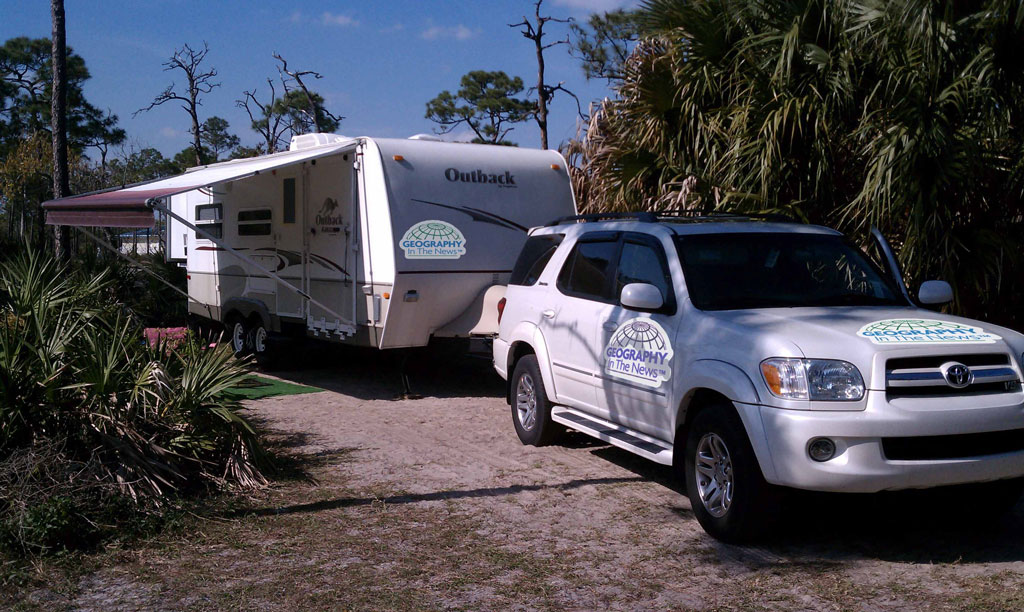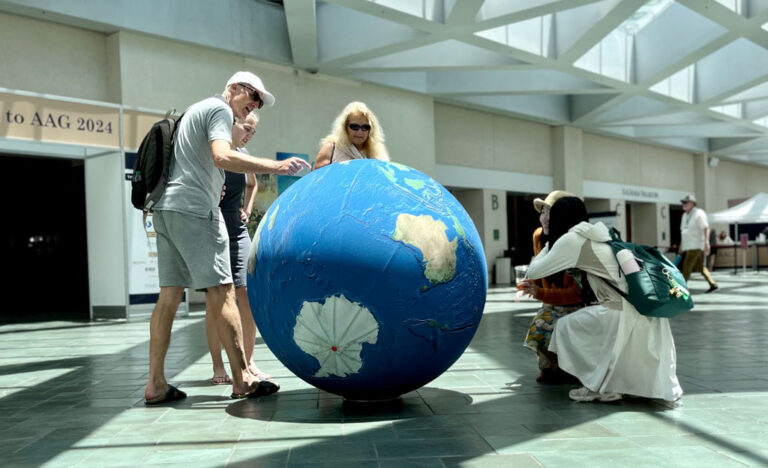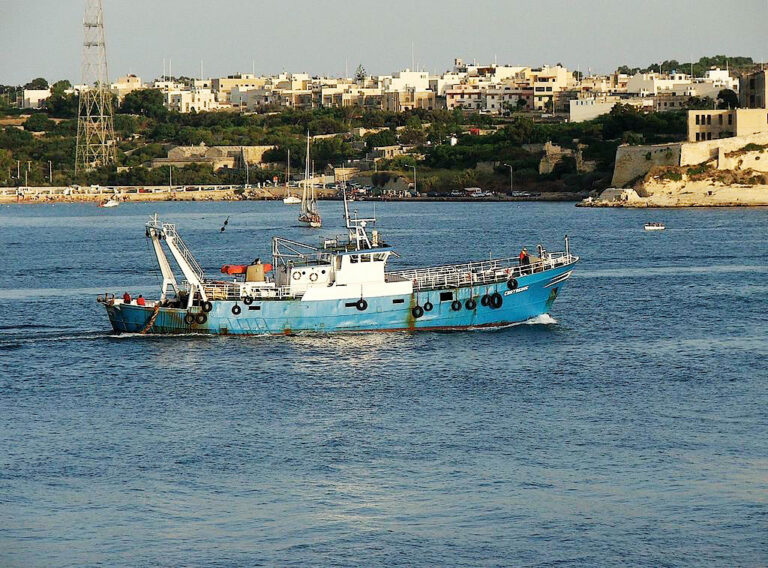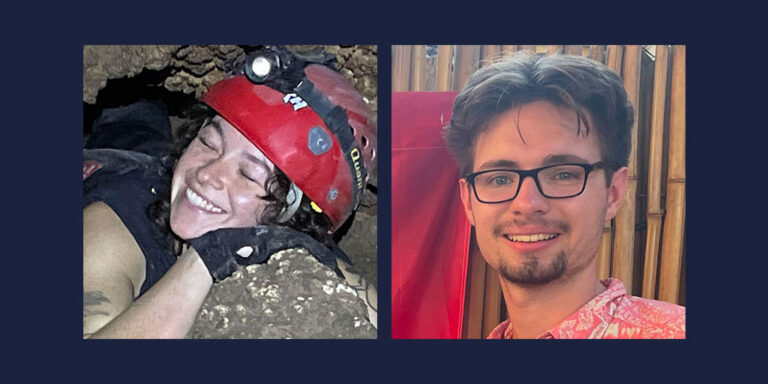Member Profile: Neal Lineback

As an adventuresome boy growing up in the 1940s and 50s in Forsyth County, North Carolina, Neal Lineback became a geographer before he knew what it was. Working summers for his uncle, a surveyor, since Neal was 11, he learned about topography and mapping by cutting brush and helping identify property lines, eventually training to operate the surveyor’s transit for observations.
“I was constantly exposed to maps and surveys. I loved maps and cartography and spent days plotting bicycle and car trips,” Lineback recalls. By the time he was 14, he had plotted an 80-mile backroad bicycle trip with a friend to earn Boy Scout merit badges. The trip was interrupted by Hurricane Hazel, the deadliest, costliest hurricane of the 1954 season. “We had to camp out in a dilapidated house at the foot of the Blue Ridge as the hurricane brought driving wind and rain,” says Lineback. “Our parents had no idea where we were.” Fortunately, the boys arrived at their destination unharmed the next day, and earned their badges.
At sixteen, Lineback bought a used Model A Ford for $100, intent on driving to Alaska. He changed his mind after the car broke down while he was still in North Carolina, resold it for the same amount he bought it for, and turned his attention to a more formal education. In the meantime, he worked a year in manufacturing as a millwright before he seriously began his college education.
Then as now, geography was a “discovery major.” It was not until his second year at East Carolina College that Lineback met two young and dynamic geography faculty, “Fritz” Gritzner and Louis DeVorsey and departmental chair Robert Cramer. “Thanks to them, I realized I had already been a geographer for 10 years and didn’t know it. Maps were my life and still are.”
In 1963, Lineback took his first teaching job, as a high school teacher in Henry County, Virginia. “I was told I was the first trained geographer to teach in the state. I entered the classroom with four things on my desk: a roll book, an out-of-date geography textbook from the 1950s, a 1930’s world map, and a paddle.” The Vietnam War was ever-present, and Lineback soon found the need to keep himself and the 30 students in five classes — many of them boys who might be drafted — up to date on the Southeast Asia daily news. That’s when he first had an epiphany about the work that would become a passion project of public scholarship: Geography in the News, which finally came to fruition nearly 25 years later and continued for more than 1,200 published articles. (In 2023, Lineback transferred the trademark and archives of Geography in the News to AAG, which is developing a repository of the articles and publishes highlights from the collection.)
College Teaching, Atlas of Alabama, and Field Work in Syria
Lineback went on to receive his Ph.D. from the University of Tennessee and also taught there for two years as a graduate student and adjunct instructor before taking up a post at the University of Alabama in Tuscaloosa. For 18 years, he served as editor of The Atlas of Alabama (1973, The University of Alabama Press) and several computer atlases, among the first of their kind. He served as department chair for 12 years, and also did field work as a hydrologist in Syria, studying the Figeh spring, which brings water to Damascus.
In 1986, when Lineback became chair of the Department of Geography and Planning at Appalachian State University, he was finally able to bring GITN to life. His idea for GITN’s journalistic approach to blending geography and current events met with the enthusiasm of dean William Byrd. What clinched it was when Lineback met political and environmental geographer Harm de Blij. “I told him that I was contemplating starting work on Geography in the News that summer. He listened intently, then said, ‘Great idea! If you don’t do it, I know of someone who will.’ I immediately pitched the idea to my local newspaper, The Watauga Democrat.”
The column was a hit with local readers and was increasingly requested by teachers. Within four years, Lineback had signed a contract to publish GITN online with Maps.Com in Santa Barbara, California. The Internet made it still easier to produce the column and send maps and text by email from coast to coast weekly.
I took considerable pride in involving both my undergraduate and graduate students in GITN and other work, particularly to the point of making sure their names were on my research papers and published maps.”
Using Geography to Delve Beneath the Headlines
How did Lineback address breaking issues in the news with thorough, thoughtful geographical perspectives week after week? The process went something like this: The first draft for the week would be written every Sunday evening, in time to meet his graduate or undergraduate cartographer on Monday morning for instructions for a map. Then he sent the draft to his long-time University News Bureau editor. Lineback used his lunch hour between classes to edit the article. After a few days of edits back and forth, Lineback would be ready to email the final version to California by 10 a.m. Friday. By this time he was doing 52 articles a year, never missing a week.
“I wrote them on vacation in Mexico, during Christmas week with the family, on a two-week cruise ship speaking tour around Scotland, Ireland, Portugal and Spain, and on fishing trips to Cape Hatteras. “Nobody else would be so stupid,” he laughs now. “It was almost non-stop for more than 20 years.”
The 27-year success of “Geography in the News” has given Lineback his greatest source of achievement. At its height, through school adoptions, subscriptions and media publications, the column enjoyed an estimated weekly readership far exceeding three million in the early 2000’s, winning awards from the AAG, SEDAAG, Travelocity and more, including a 2-year run on the NGS Newswatch blog.

During the last five years he teamed with his daughter, geographer Mandy Gritzner. “A Godsend,” he says. He continued to teach two or three classes per semester, preside as Department Chair, and serve on AAG and University committees, as well as writing for research projects, including a co-author of Global Change in Local Places, funded by NASA through the AAG. He debuted the World Geography Bowl to SEDAAG (1990) and two years later at AAG after witnessing it as a simple game among North Carolina college students and realized that it could be a thrilling exercise for both geography students and faculty. It was immediately a resounding success. The World Geography Bowl is now a popular event at the AAG annual meeting.
In his experiences, “Geography departments should adopt the academic model of a three-legged stool: promoting well-rounded faculty who carry out good teaching, provide good academic service to their disciplines, and accomplish/publish research in their field,” says Lineback. “In all of these tasks, they should involve their students. I took considerable pride in involving both my own undergraduate and graduate students, particularly to the point of making sure their names were on my research papers and published maps. University teaching shouldn’t go on solely in the classroom.”


